18.07.2020
Scientists identify gel-like substance found on Moon
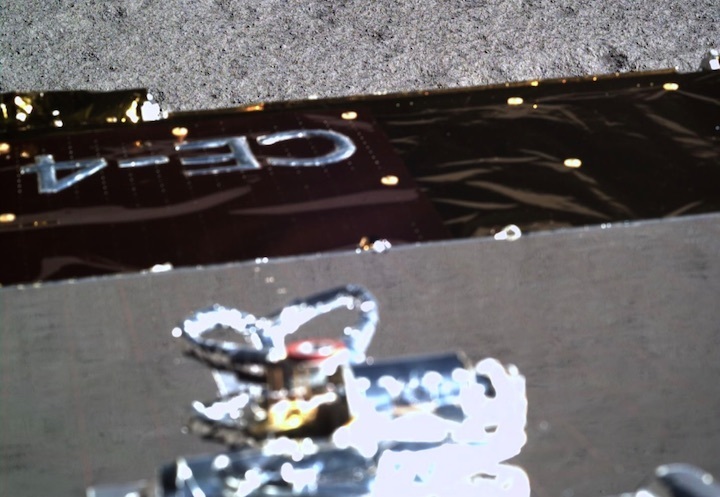
Chinese researchers have published an analysis of a gel-like substance spotted by the country's Yutu-2 lunar rover in a crater on the far side of the moon last year.
In a research paper published in the journal Earth and Planetary Science Letters, researchers from institutes under the Chinese Academy of Sciences described the substance as "a dark greenish and glistening impact melt breccia" on the floor of the Von Karman crater on the far side of the moon. It measures about 52 cm by 16 cm.
Breccia is a type of rock composed of angular fragments of minerals or rock cemented together.
The researchers compared the images taken by the lunar rover with samples brought back from the moon by the U.S. Apollo missions. They found that the substance resembled the Apollo samples, suggesting that it could be formed by some violent impact, such as a meteorite that crashed into the moon.
They said that the impact melted some lunar regolith and breccia together, which formed the substance. Lunar regolith refers to the mixture of powdery dust and broken rock that covers the surface of the moon.
The Chang'e-4 probe, launched on Dec. 8, 2018, made the first-ever soft landing on the Von Karman Crater in the South Pole-Aitken Basin on the far side of the moon on Jan. 3, 2019.
The rover Yutu-2, or Jade Rabbit-2, has worked much longer than its three-month design life, becoming the longest-working lunar rover on the moon. Enditem
Quelle: Xinhua
----
Update: 23.07.2020
.
Study Reveals Composition of "Gel-like" Substance Discovered by Chang'e-4 Rover on Moon's Far Side
The unusual dark greenish and glistening "gel-like" substance in a crater on the far side of the moon has attracted widespread interest following its discovery by the Chang'e-4 rover in July 2019.
A research team led by Prof. DI Kaichang from the Aerospace Information Research Institute (AIR) of the Chinese Academy of Sciences and their collaborators analyzed the substance in detail by using multiple datasets from the rover's panoramic camera (Pancam), hazard avoidance camera (Hazcam), and the visible and near-infrared spectrometer (VNIS).
The researchers found that the unusual substance is actually an impact melt breccia, and the provenance of the rover measured surrounding regolith might originate from a differentiated melt pool or from a suite of igneous rocks. Their findings were published in Earth and Planetary Science Letters.
China's Chang'e-4 probe, including a lander and a rover, successfully touched down within the 185-km-wide Von Kármán crater inside the South Pole-Aitken (SPA) basin on January 3, 2019, making the first-ever soft landing on the lunar far side.
The gel-like substance was discovered in a crater (Fig. 1) during the eighth lunar day of the rover's mission. Detailed measurements on the breccia and surrounding regolith were conducted during the ninth lunar day.
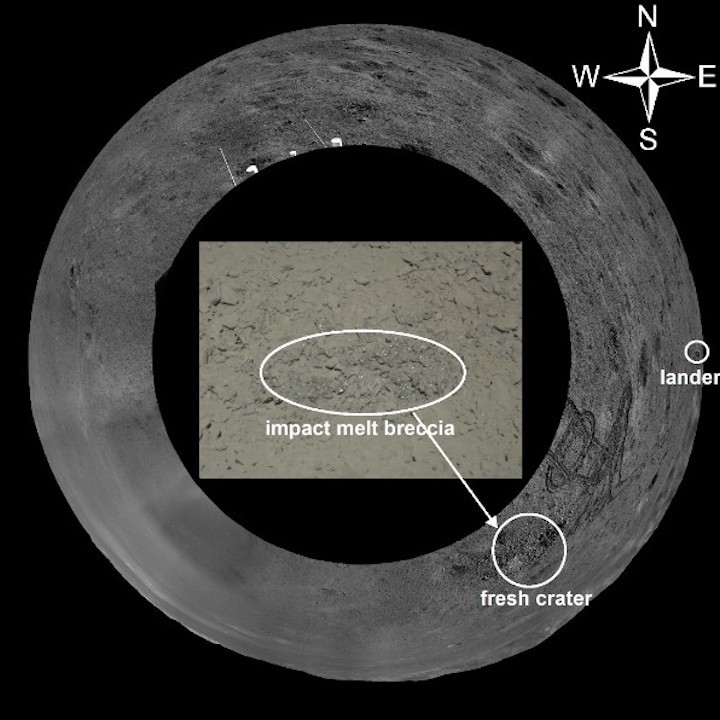
Fig. 1. Impact melt breccia and surrounding context (Image by CNSA, CLEP, and AIR)
The discovered breccia, measuring 52 by 16 centimeters, resembles the lunar impact melt breccia samples 15466 and 70019 (Fig. 2) returned by the Apollo missions. It was formed by impact-generated welding, cementing and agglutinating of lunar regolith and breccia.
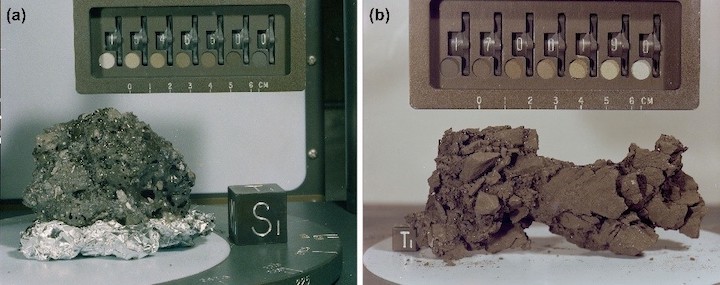
Fig. 2. Photos of lunar impact melt breccia samples (Image by NASA and AIR)
Clods surrounding the breccia-hosting crater were crushed into regolith powders by the rover’s wheels (Fig. 3), indicating the regolith may be compacted slightly and becomes blocky and friable.

Fig. 3. Hazcam images show the rover’s locations (Image by CNSA, CLEP, and AIR)
Hapke model-based spectral unmixing results showed that plagioclase was abundant, and pyroxene and olivine had almost equal fractions, indicating the regolith was likely the weathering products of noritic rocks.
The regolith measured by Chang’e-4 rover was actually a mixture of multiple sources, with ejecta from Finsen crater being primary and possible contributions from Alder crater. Finsen and Alder craters are on the margin of the proposed impact melt pool produced by the SPA basin-forming event. Therefore, the provenance of the regolith might originate from a differentiated melt pool or from a suite of igneous rocks.
Quelle: Chinese Academy of Sciences
----
Update: 1.08.2020
.
China's Chang'e 4 moon mission completes 20th day on lunar farside
It provided the first deep view below the lunar surface.
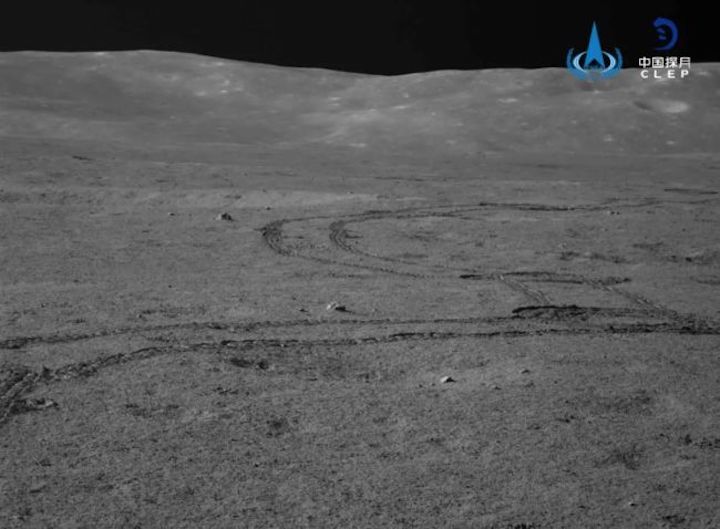
China's Chang'e 4 moon lander and rover have concluded their science tasks for a 20th lunar day on the far side of the moon.
Both the mission's lander and Yutu 2 rover resumed their activities on July 14 following sunrise over their location in Von Kármán crater on the far side of the moon. The lander powered down July 26 at 10:20 p.m. EDT (0220 GMT July 27), with Yutu 2 having already gone into a dormant state about 10 hours earlier, at 12:34 p.m. EDT (1634 GMT).
Yutu 2 continued on its planned journey to the northwest of the lander, according to the China Lunar Exploration Program (CLEP). The rover covered 90 feet (27.64 meters) during the lunar day to make a total of 1,610 feet (490.9 m) of roving since setting down on the far side of the moon in January 2019.
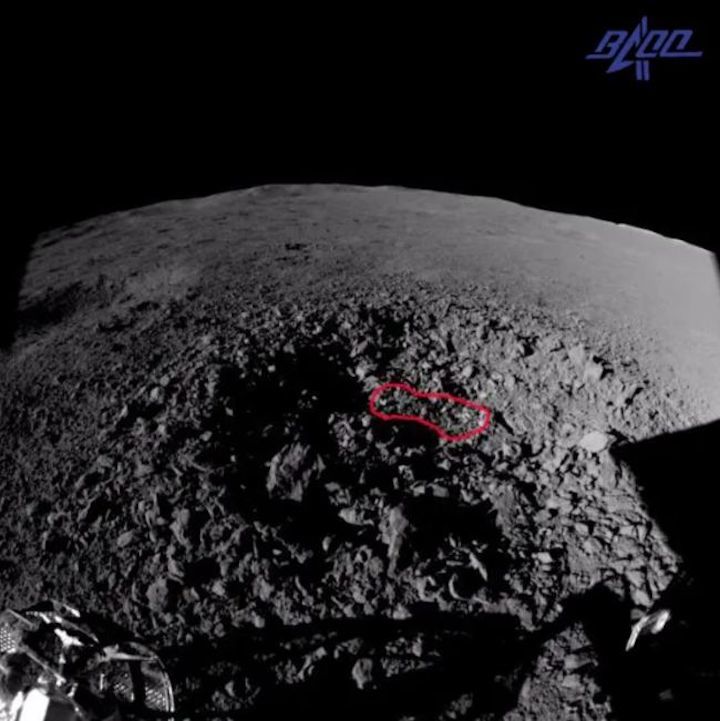
All of Chang'e 4's science instruments — including a low-frequency astronomy payload on the lander and a spectrometer for analyzing the composition of the lunar surface — are working well, according to CLEP.
During the previous lunar day (June 14-27), Yutu 2 checked out a small crater containing relatively reflective material at its center, according to Our Space, a Chinese-language science-outreach publication. It is likely to be similar to a discovery of which last year generated widespread interest but was recently confirmed by scientists to most likely be impact melt glass.
Data from another Yutu 2 instrument — the ground-penetrating radar — has also been used to provide a first deep look below Von Kármán crater in a paper published July 9 in the journal Nature Communications.
The radar operates at two frequencies, 60 MHz and 500 MHz. Another paper published in February in the journal Science Advances used the higher-frequency data to reveal three distinct layers beneath Yutu 2 down to 130 feet (40 m). The new paper uses the lower-frequency data which provides a deeper look, between 170 and 1,076 feet (52 to 328 m).
The detections reveal that buried ejecta from major impacts is overlaid by at least four layers of distinct lava flows. The data provides direct evidence of multiple lava-infilling events, likely occurring during the Imbrium epoch, between roughly 3,850 and 3,200 million years ago.
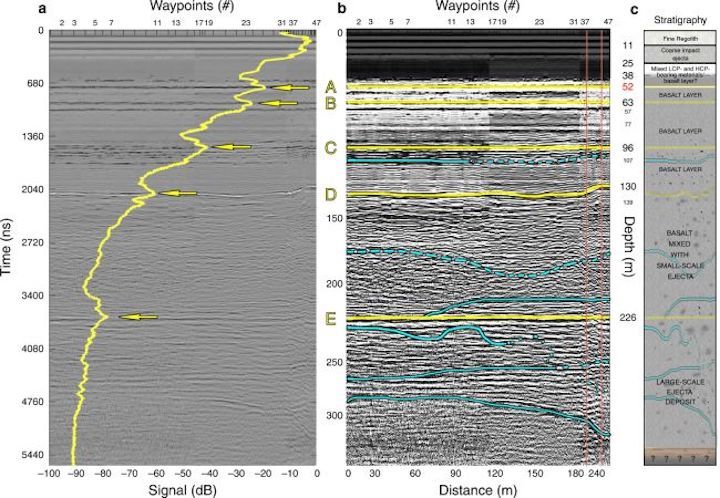
The researchers use the readings and earlier papers to build a possible history of Von Kármán crater, suggesting which impact events may have created particular subsurface strata.
The solar powered lander and Yutu 2 will wake up between 24 and 48 hours after local sunrise on Aug. 11 to begin lunar day 21. The spacecraft power down ahead of every roughly 14.5-Earth day lunar nighttime due to lack of sunlight and to protect against the deep cold.
Quelle: SC
----
Update: 15.08.2020
.
China's Chang'e-4 probe resumes work for 21st lunar day
The lander and rover of the Chang'e-4 probe have resumed work for the 21st lunar day on the far side of the moon.
The lander woke up at 14:54 Thursday (Beijing Time) while the rover awoke at 20:34 Wednesday. Both are in normal working order, according to the Lunar Exploration and Space Program Center of the China National Space Administration.
The Chang'e-4 probe was launched on Dec. 8, 2018. It made the first-ever soft landing on the Von Karman Crater in the South Pole-Aitken Basin on the far side of the moon on Jan. 3, 2019.
A lunar day is equal to 14 days on Earth, and a lunar night is the same length.
The rover will continue to move northwest toward the basalt area or the impact craters with high reflectivity, according to the center.
The panoramic camera, near-infrared spectrometer, neutral atom detector and lunar radar of the rover will continue to carry out planned scientific exploration. Enditem
Quelle: Xinhua
----
Update: 1.09.2020
.
China's Chang'e-4 probe survives 600 Earth days on Moon's far side
China's Chang'e 4 probe has survived more than 600 Earth days on the far side of the moon while conducting scientific explorations.
With a variety of scientific gear on board, the Chinese lunar probe observed and measured the exotic land, offering unprecedented views and understanding of the far side of the moon and beyond.
As of last Wednesday, the lander and the rover of the Chang'e-4 probe have completed work for the 21st lunar day on the far side of the moon and is currently in dormant mode during the lunar night due to lack of solar power, according to the Lunar Exploration and Space Program Center of the China National Space Administration.
Last Tuesday was the 600th day of Chang'e-4 on the moon and the rover had traveled 519.29 meters.
The rover Yutu-2, or Jade Rabbit-2, has far exceeded its three-month design lifespan, becoming the longest-working lunar rover on the moon.
With the help of data transmitted to Earth, Chinese researchers have made progress in vital research such as the moon's geological evolution, radiation and low-frequency radio environment. Enditem
Quelle: Xinhua
----
Update: 10.09.2020
.
China Focus: China's Chang'e-4 probe reveals landing site impact history on moon's far side
Based on data from China's Chang'e-4 probe, Chinese scientists have determined the thickness of the regolith and revealed the fine subsurface structures and evolutionary history of the probe's landing site on the moon's far side.
The study revealed that the landing area of the probe, located within the largest and oldest impact basin on the moon, had experienced multiple impact events and basalt magma eruptions.
The Chang'e-4 probe, launched on Dec. 8, 2018, made the first-ever soft landing on the Von Karman Crater in the South Pole-Aitken Basin on the far side of the moon on Jan. 3, 2019.
Carrying scientific instruments including a lunar penetrating radar, the rover Yutu-2 has conducted scientific detection on the compositions of lunar surface materials and the subsurface structures.
Scientists from the Institute of Geology and Geophysics (IGG) under the Chinese Academy of Sciences (CAS), the Aerospace Information Research Institute under the CAS, the Macao University of Science and Technology and other institutes have carried out research on the lunar penetrating radar onboard Yutu-2 during the first three lunar days and obtained important findings on the subsurface structure of the landing area.
The results showed that the materials detected by Yutu-2 come from the nearby Finsen impact crater rather than the basalt erupted from the lunar mantle, which filled the bottom of the Von Karman Crater. It was also revealed that the landing area had experienced multiple impact events and basalt magma eruptions.
The new discoveries are of great significance to understanding the evolutionary history of the South Pole-Aitken basin of the moon, as well as to the following exploration and research on the composition and structure of the lunar interior, said Lin Yangting, a researcher with the IGG.
Asteroid impacts are an important driving force for the early evolution of the Earth. However, the long-term geological tectonic activities have erased most of the traces of the impact cratering events on Earth, experts said.
The internal evolution of the moon has long ceased due to its small mass. Therefore, impact craters and the deposit profile of crater ejecta on the lunar surface have recorded the impact history of asteroids in the earth-moon system.
According to Lin, the subsurface structure of the moon recorded the number and scale of large-scale impact events and magma eruptions, as well as their temporal and spatial relationships. However, the fine structure of the moon's shallow layers remains a mystery to humans.
The modification of lunar surface materials by asteroid impacts has a direct influence on the results obtained from orbital observations and landing site reconnaissance, and affects how scientists will implement the lunar sample return missions in the future, Lin said.
Quelle: Xinhua
----
Update: 13.09.2020
.
China's Chang'e-4 probe resumes work for 22nd lunar day
The lander and rover of the Chang'e-4 probe have resumed work for the 22nd lunar day on the far side of the moon.
The lander woke up at 5:15 a.m. on Saturday (Beijing time), and the rover Yutu-2, or Jade Rabbit-2, woke up at 11:54 a.m. on Friday, sources with the Lunar Exploration and Space Program Center of the China National Space Administration said.
The Chang'e-4 probe, launched on Dec. 8, 2018, made the first-ever soft landing on the Von Karman Crater in the South Pole-Aitken Basin on the far side of the moon on Jan. 3, 2019.
A lunar day is equal to 14 days on Earth, and a lunar night is of the same length. The Chang'e-4 probe, switching to dormant mode during the lunar night due to the lack of solar power, has survived about 618 Earth days on the moon.
According to the center, Yutu-2 will move northwest toward the basalt area or the impact craters with high reflectivity during the 22nd lunar day. Scientific instruments such as a panoramic camera, infrared imaging spectrometer, neutral atom detector, as well as lunar radar on the rover will carry out scientific detection.
The solar-powered rover has far exceeded its three-month design lifespan, becoming the longest-working lunar rover on the moon. Enditem
Quelle: Xinhua
----
Update: 24.09.2020
.
China's Chang'e-4 probe switches to dormant mode
The lander and the rover of the Chang'e-4 probe have been switched to dormant mode for the lunar night after working stably for a 22nd lunar day, according to the Lunar Exploration and Space Program Center of the China National Space Administration.
The lander was switched to dormant mode at 7:30 a.m. on Thursday (Beijing Time) as scheduled, and the rover, Yutu-2 (Jade Rabbit-2), at 11:18 p.m. on Wednesday, said the center on its official social media platform accounts.
A lunar day is equal to 14 days on Earth, and a lunar night is the same length. The Chang'e-4 probe, switching to dormant mode during the lunar night due to the lack of solar power, has survived 630 Earth days on the far side of the moon as of Thursday, and the rover has traveled 547.17 meters.
During the 22nd lunar day, Yutu-2 explored an impact crater about 1.3 km northwest of the landing site.
The Chang'e-4 probe, launched on Dec. 8, 2018, made the first-ever soft landing on the Von Karman Crater in the South Pole-Aitken Basin on the far side of the moon on Jan. 3, 2019. Enditem
Quelle: Xinhua
----
Update: 26.09.2020
.
China's Chang'e-4 probe switches to dormant mode
The lander and the rover of the Chang'e-4 probe have been switched to dormant mode for the lunar night after working stably for a 22nd lunar day, according to the Lunar Exploration and Space Program Center of the China National Space Administration.
The lander was switched to dormant mode at 7:30 a.m. on Thursday (Beijing Time) as scheduled, and the rover, Yutu-2 (Jade Rabbit-2), at 11:18 p.m. on Wednesday, said the center on its official social media platform accounts.
A lunar day is equal to 14 days on Earth, and a lunar night is the same length. The Chang'e-4 probe, switching to dormant mode during the lunar night due to the lack of solar power, has survived 630 Earth days on the far side of the moon as of Thursday, and the rover has traveled 547.17 meters.
During the 22nd lunar day, Yutu-2 explored an impact crater about 1.3 km northwest of the landing site.
With a near-infrared spectrometer, panoramic camera and lunar radar carried by Yutu-2, the rover can peer beneath the surface of the mysterious far side of the moon.
According to a recent study published in the journal Nature Astronomy, Chinese researchers have determined the thickness of the regolith and revealed the fine subsurface structures and evolutionary history of the Chang'e-4's landing site.
The results showed the materials detected by Yutu-2 come from the nearby Finsen impact crater rather than the basalt erupted from the lunar mantle.
It was further revealed that the Von Karman Crater, the landing area of the Chang'e-4, had experienced multiple impacts and basalt magma eruptions.
The latest discoveries are of great significance for understanding the evolutionary history of the South Pole-Aitken basin of the moon, as well as for exploration and research on the composition and structure of the lunar interior.
The Chang'e-4 probe, launched on Dec. 8, 2018, made the first-ever soft landing on the Von Karman Crater in the South Pole-Aitken Basin on the far side of the moon on Jan. 3, 2019. Enditem
Quelle: Xinhua
----
Update: 27.09.2020
.
How intense and dangerous is cosmic radiation on the Moon?
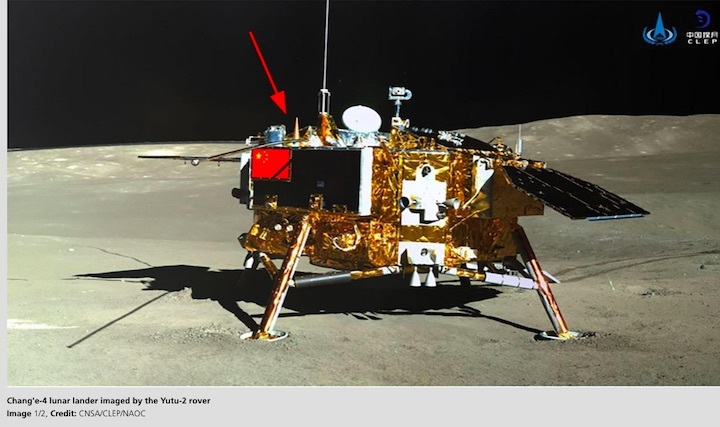
- A German instrument has measured space radiation in temporal resolution for the first time on the far side of the Moon.
- The journal Science Advances reports on the work of an international group of scientists, in which DLR was also involved.
- The LND instrument is located on board the Chinese Chang'e-4 lunar lander.
- Focus: human spaceflight, health in space, international cooperation
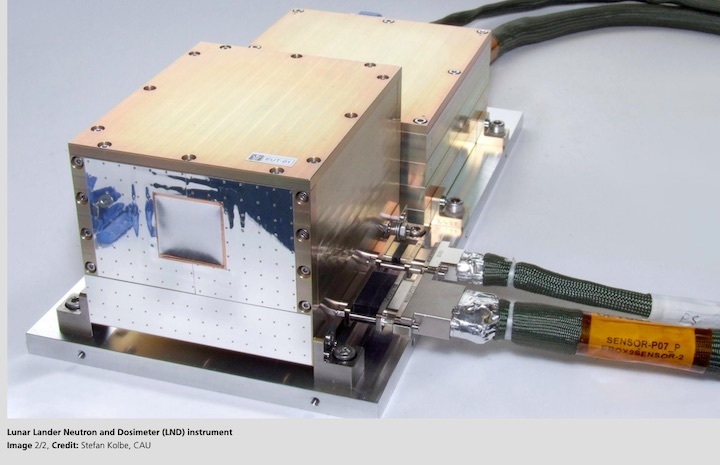
The Chang'e-4 lunar lander touched down on the far side of the Moon on 3 January 2019, with a German instrument for measuring space radiation on board. Since then, the Lunar Lander Neutron and Dosimetry (LND) instrument has been measuring temporally resolved cosmic radiation for the first time. Earlier devices could only record the entire 'mission dose'. In its current issue, the scientific journal Science Advances reports on the work of the international group of scientists involved with the LND, including researchers from the German Aerospace Center (Deutsches Zentrum für Luft- und Raumfahrt; DLR). Their investigations have involved more precise radiation measurements on the Moon.
"Over the coming years and decades, various nations are planning to send crewed missions to explore the Moon. Space radiation poses a significant risk to the health of humans. The Apollo astronauts carried radiation measuring devices, referred to as dosimeters, on their bodies. But these only determined the radiation exposure over the course of the entire mission," says Oliver Angerer, LND Project Manager at the DLR Space Administration. With the LND instrument it is possible to measure the various characteristics of the radiation field over time intervals of one, 10 or 60 minutes. This enables researchers to calculate the 'equivalent dose', which is important for estimating biological effects.
High radiation exposure in a spacesuit
DLR radiation physicist Thomas Berger from the DLR Institute of Aerospace Medicine, who participated in the publication explains: "The radiation exposure we measured is a good indication of the radiation inside a spacesuit. The measurements give us an equivalent dose rate – the biologically weighted radiation dose per unit of time – of around 60 microsieverts per hour. For comparison, during a long-haul flight from Frankfurt to New York, the dose rate is five to 10 times lower than this. On Earth's surface, it is some 200 times lower. In other words, a long-term stay on the Moon will expose astronauts' bodies to high doses of radiation."
"Human bodies are simply not made to be exposed to space radiation," adds Robert Wimmer-Schweingruber of the Christian-Albrecht University (CAU) in Kiel, whose team developed and built the LND instrument . "On longer missions to the Moon, astronauts will have to protect themselves from it – by covering their habitat with a thick layer of lunar rock, for example. This could reduce the risk of cancer and other illnesses caused by long periods of time spent on the Moon."
The instrument developed in Kiel conducts measurements throughout the lunar day, but like all other scientific devices on the lander, remains switched off throughout the extremely cold, approximately two-week lunar night, to save power. The instrument and lander were designed to conduct their measurements for at least one year – a target they have already surpassed. The data from the LND and the lander are transmitted to Earth via the relay satellite Queqiao ('Magpie Bridge'), which is located above the far side of the Moon.
Astronautical space exploration on the Moon and beyond
The radiation data are also relevant for future interplanetary missions. Since the Moon has neither a protective magnetic field nor an atmosphere, the radiation field on the Moon's surface is similar to that in interplanetary space. "With that in mind, the LND measurements are also used to develop computer models to calculate the expected radiation exposure, refine our models and thus contribute towards our work on radiation protection for astronauts on future missions. It is vital that the detector also allows conclusions to be drawn about the composition of the radiation field, such as how many neutrons and high energy-charged particles are present," explains Berger.
Funding
The Lunar Lander Neutron and Dosimetry (LND) instrument was developed and built at the Christian-Albrecht University of Kiel on behalf of the DLR Space Administration with funding from the German Federal Ministry of Economic Affairs and Energy (Bundesministerium für Wirtschaft und Energie; BMWi). The research conducted by the DLR Institute of Aerospace Medicine is supported by the Moon and Mars Exploration Studies (MoSES) project, which is part of DLR's Space Exploration Programme.
Quelle: DLR
----
Update: 12.10.2020
.
China's Chang'e-4 probe resumes work for 23rd lunar day
The lander and rover of the Chang'e-4 probe have resumed work for the 23rd lunar day on the far side of the moon.
The lander woke up at 11:56 a.m. Sunday, Beijing Time, and the rover Yutu-2, or Jade Rabbit-2, woke up at 6:57 p.m. Saturday, said sources with the Lunar Exploration and Space Program Center of the China National Space Administration.
A lunar day is equal to 14 days on Earth, and a lunar night is of the same length. The solar-powered probe switches to dormant mode during the lunar night.
Landing on the moon on Jan. 3, 2019, the Chang'e-4 probe has survived about 647 Earth days on the moon.
During the 23rd lunar day, Yutu-2 will move northwest toward the basalt area or the impact craters with high reflectivity. It will also use an infrared imaging spectrometer onboard to carry out the scientific detection of a lunar rock, which has a diameter of 30 cm, according to the center.
The rover has far exceeded its three-month design lifespan, becoming the longest-working lunar rover on the moon. Enditem
Quelle: Xinhua
----
Update: 17.10.2020
.
China's moon mission robots wake up for a 23rd lunar day as team snags major award
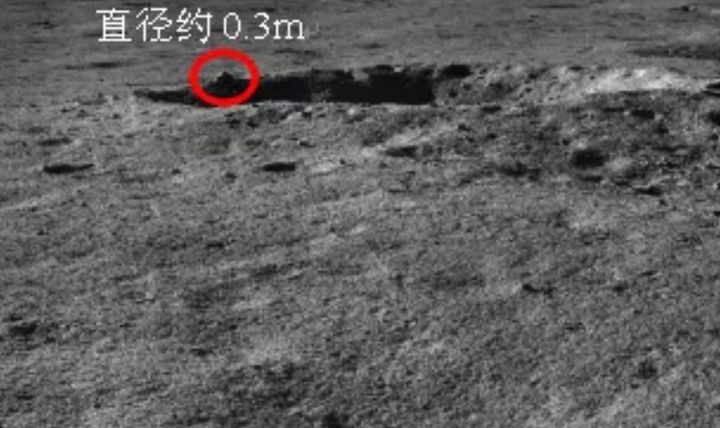
China's Chang'e 4 spacecraft have awoken for another lunar day on the far side of the moon, while on Earth the mission received a prestigious international award for its accomplishments.
The Chang'e 4 mission, which consists of a lander and a rover, made the first-ever touchdown on the far side of the moon on Jan. 3, 2019. Since then, the two robots have lasted 648 days, returning reams of science data and images from Von Kármán Crater during the local day; the rover and lander hibernate during the roughly 14-Earth-day-long lunar nights.
In recognition of the mission's exploration and science achievements, the International Astronautical Federation (IAF) chose to present the World Space Award to three of Chang'e 4's leaders. The award recognizes outstanding contributions to space science, space technology, space medicine, space law or space management.
Yu Dengyun, Sun Zezhou and Wu Weiren received the accolade, with Yu, the deputy designer-in-chief of China's Lunar Exploration Program, delivering a highlight lecture at the 71st International Astronautical Congress 2020 on Monday (Oct. 12) to mark the award. The annual event was held online due to the COVID-19 pandemic.
Yu's talk highlighted a number of breakthroughs that made the mission possible. Among these were demonstrating the first continuous, reliable communication with the far side of the moon through the Queqiao relay satellite. Queqiao orbits a special, gravitationally stable point beyond the moon, from which it maintains constant line-of-sight with both ground stations on Earth and the spacecraft on the lunar far side, enabling communications.
Another key challenge to the Chang'e 4 mission was developing the capability for an autonomous, high-precision landing in complex terrain on the lunar far side. Notably the landing area available to Chang'e 4 was just 5% that of its predecessor mission, Chang'e 3, which landed on the near side in 2013.
Yu also highlighted breakthroughs in ground control, launch systems and the Longjiang-2 microsatellite, whose feats included using independent propulsion to enter lunar orbit and, amazingly, imaging a solar eclipse in South America from the moon. Yu also revealed that the first radioisotope thermoelectric generator developed in China was used on the mission and performed well.
In addition to the technological breakthroughs, Yu discussed science highlights of the mission so far, including insights into the lunar subsurface structure using a penetrating radar, potential radiation doses astronauts will receive on the moon and the composition of materials discovered by the rover; the mission is also taking unprecedented low-frequency radio astronomy measurements.
The Chang'e 4 robots began their 23rd lunar day of activities over the weekend. The Yutu 2 rover resumed work on Oct. 10 with the lander following suit on Oct. 11.
Yutu 2 is set to continue its journey northwest from the landing site and will target a roughly 12-inch (30 centimeters) rock on the rim of a nearby crater for analysis with a spectrometer. The rover has used that instrument to analyze a range of specimens in Von Kármán crater, notably causing a stir when it discovered an impact melt breccia initially described as "gel-like."
China's Lunar Exploration Program released a seventh batch of science data from the mission on Oct. 9, including data from the lander's low-frequency astronomy instrument and the Yutu 2 rover's radar, spectrometer and panoramic camera.
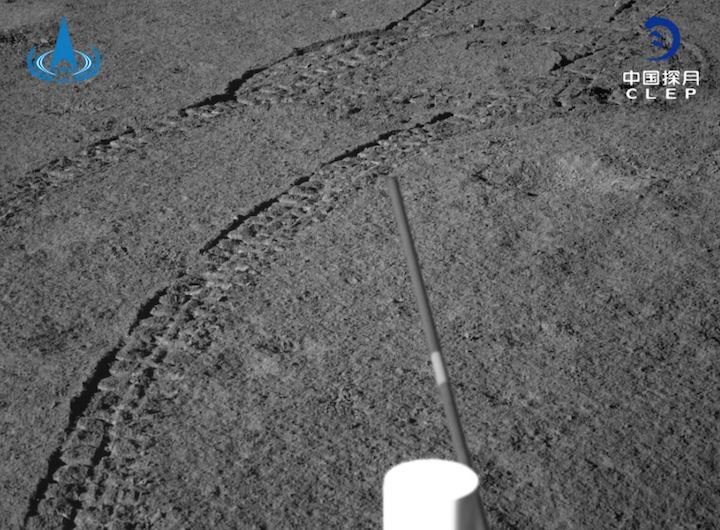
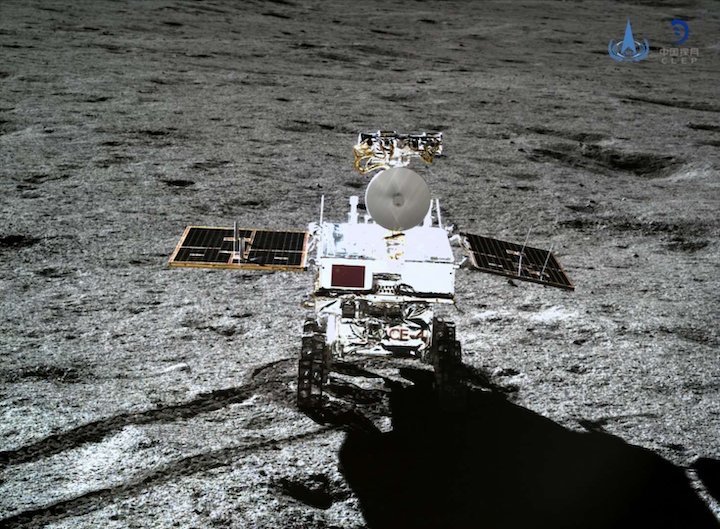
The Chang'e 4 mission involved thousands of scientists and engineers in China as well as payload contributions from Germany, Sweden, the Netherlands and Saudi Arabia. Russia contributed radioisotope batteries to keep the spacecraft warm during the deep cold of the lunar night, while Argentina has assisted with ground station support.
Chang'e 4 was originally a backup to Chang'e 3, which successfully landed in Mare Imbrium in 2013. That mission's lander and one of its science payloads remain operational after nearly 7 years on the lunar surface.
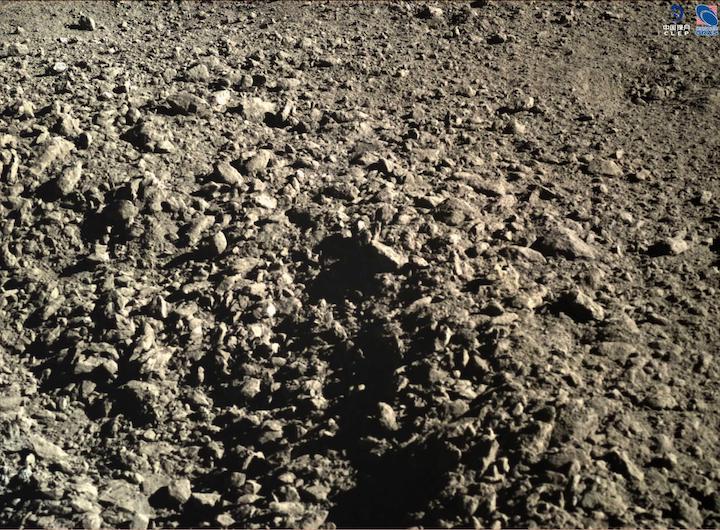
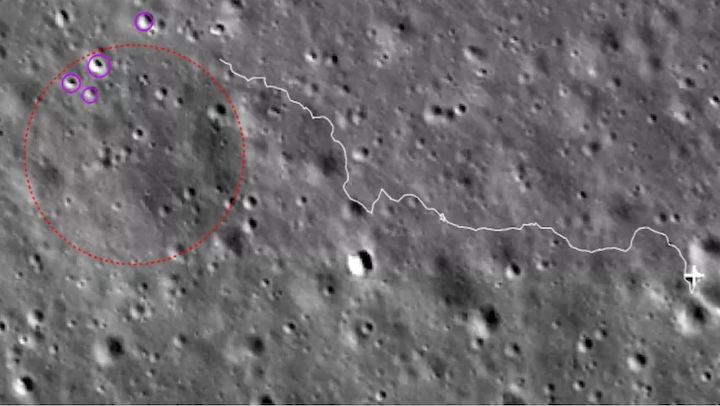
Quelle: SC
----
Update: 25.10.2020
.
China's lunar rover travels 565.9 meters on moon
The lander and the rover of the Chang'e-4 probe have been switched to the dormant mode for the lunar night after working stably for the 23rd lunar day, according to the Lunar Exploration and Space Program Center of the China National Space Administration.
The lander was switched to dormant mode at 9:40 p.m. Friday (Beijing Time) as scheduled, and the rover, Yutu-2 (Jade Rabbit-2), at 12 noon Friday, said the center.
A lunar day is equal to 14 days on Earth, and a lunar night is the same length. The Chang'e-4 probe, which switched to dormant mode during the lunar night due to the lack of solar power, had been on the far side of the moon for 660 Earth days as of Saturday, and the rover has traveled 565.9 meters.
During the 23rd lunar day, Yutu-2 went northwest, traveling toward an area with basalt and an impact crater area with high reflectivity. En route to the destination, the near-infrared spectrometer on the rover was used to detect a rock about 30 cm in diameter. The research team is analyzing the transmitted data.
Scientists carried out the first systematically documented measurements of radiation on the moon with data acquired by the neutron radiation detector onboard. According to the study published in the journal Science Advances, the moon's surface is highly radioactive, approximately two to three times the International Space Station, five to ten times a civil flight, and 300 times the surface of the earth of Beijing.
The study provided a reference for the estimation of the lunar surface radiation hazards and the design of radiation protection for future lunar astronauts.
The Chang'e-4 probe, launched on Dec. 8, 2018, made the first-ever soft landing on the Von Karman Crater in the South Pole-Aitken Basin on the far side of the moon on Jan. 3, 2019.
The rover Yutu-2 has far exceeded its three-month design lifespan, becoming the longest-working lunar rover on the moon.
Oct. 24 is a significant day for China's lunar exploration.
On Oct. 24, 2007, China's first lunar probe Chang'e-1 was launched, making China the fifth country to develop and launch a lunar probe on its own and opening up a new age of deep space exploration for China.
It mapped 3D images of the lunar surface, analyzed the distribution of elements, measured the depth of lunar soil, and explored the environment between Earth and moon. Chinese scientists released the first complete map of the moon's surface in November 2008, thanks to Chang'e-1.
After orbiting the moon for about 16 months, the probe made a controlled crash on the lunar surface in March 2009.
On Oct. 24, 2014, China launched an experimental spacecraft to test technologies to be used in the Chang'e-5, which is expected to bring moon samples back to Earth.
The spacecraft, comprising a re-entry capsule and a service module, flew around the moon for half a circle. The return capsule touched down at the designated landing area in Siziwang Banner, north China's Inner Mongolia Autonomous Region, on Nov. 1, 2014. Enditem
Quelle: Xinhua
----
Update: 11.11.2020
.
China's Chang'e-4 probe resumes work for 24th lunar day
The lander and rover of the Chang'e-4 probe have resumed work for the 24th lunar day on the far side of the moon.
The lander woke up at 3:12 a.m. Tuesday, Beijing Time, and the rover Yutu-2, or Jade Rabbit-2, woke up at 10:17 a.m. Monday, according to the Lunar Exploration and Space Program Center of the China National Space Administration.
Landing on the moon on Jan. 3, 2019, the Chang'e-4 probe has survived 677 Earth days on the moon. Enditem
Quelle: Xinhua
